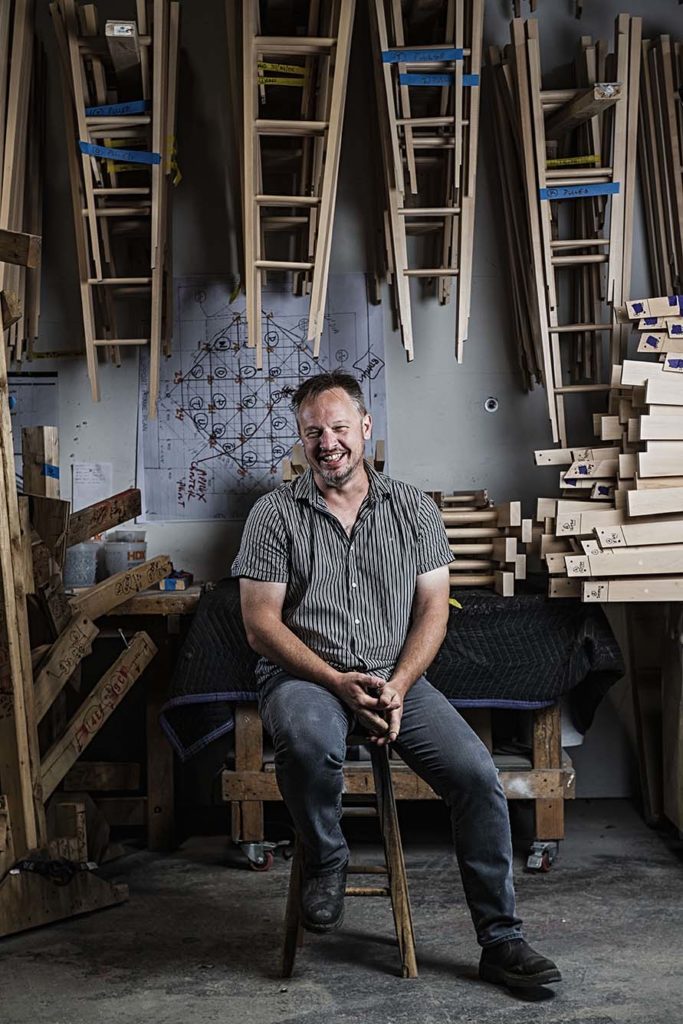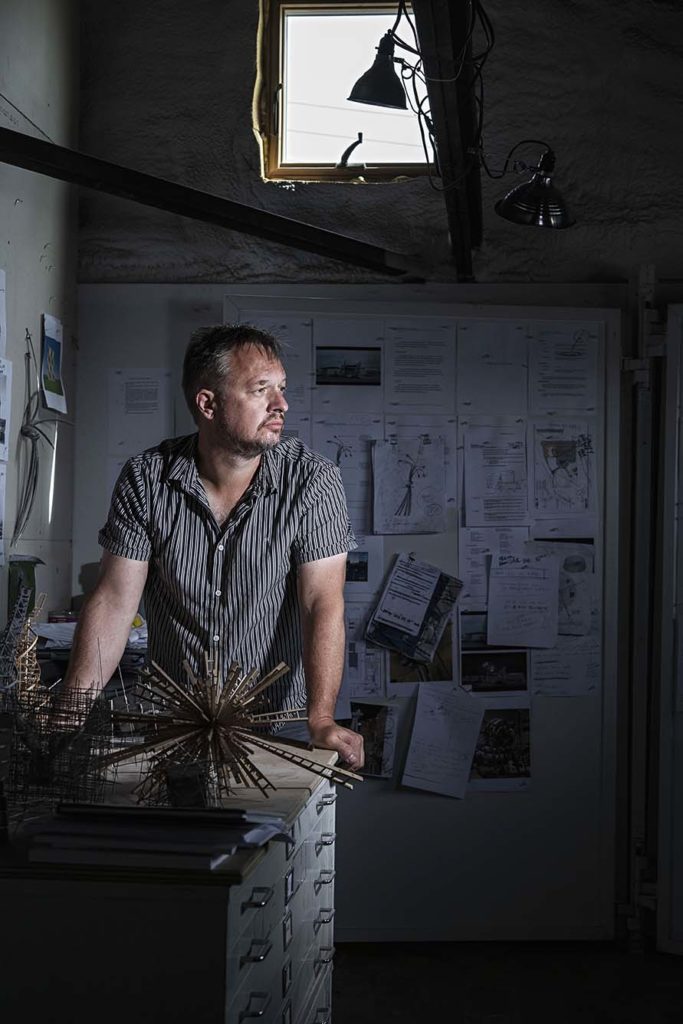The Portland Artist Creating Dialogue with Everyday Objects
Known for his large-scale public installations, Aaron T Stephan doesn’t want to create work that everyone likes.

Aaron T Stephan creates his large-scale public art installations in his warehouse-sized studio on Portland’s western waterfront. Most recently, the studio needed to be big enough to fit hundreds of ladders for a piece being installed at a Florida airport, but it has also been home to a massive sculpture of twisted guardrails, towers of handmade cinder blocks, and a performance-art dinner party hosted by him and his wife, artist Lauren Fensterstock, that involved dropping a piano when a candle burned through the rope holding it up, then cooking over a fire made with the smashed pieces of the instrument. His work often reimagines everyday objects, such as his Paths Rising piece that will be at Tampa International Airport: more than 300 handcrafted wooden ladders will be suspended in a cylindrical hole in the ceiling lined with gold leaf. His most recent permanent installation in Maine is the curved, tree-like streetlight sculpture illuminating the five-way intersection in Portland’s Woodfords Corner. Stephan says he uses familiar objects in his artwork partly because they mean something different to every person, encouraging dialogue. People bring their own history and association with an object, whether it is a cinder block or a ladder. “It’s simple, and hopefully it takes you somewhere else,” he says.
How do you approach work you do for galleries and public artwork differently?
I strive to make sure I’m doing both. They feed off of each other. With public work you have this amazing sense of ownership. You know where it’s going to go. You make a piece in the studio that goes into a gallery; you don’t know where it’s going to go afterward. Also, with public work, I can do things on a scale that I just can’t do by myself. Those are all incredible advantages, but at the same time, each project I’m working on, I’m three-or four-years in. They’re very long-term, so you have to figure out how to build spontaneity into the process somehow, which is difficult when you’re working with engineers and community members and municipalities.

“Honestly, if I made something that everybody liked, I’d be really disappointed.”
With public installations, how do you deal with negative feedback?
Honestly, if I made something that everybody liked, I’d be really disappointed. It just doesn’t happen that way. Some people like Led Zeppelin, some people like Pink Floyd. People are different. With public work there’s often a lot of baggage involved, as far as how it’s being paid for and things like that. But I’m not here to please people. I’m here to create a dialogue, I’m here to create a discussion, and that’s what I’m focused on. I want to keep an eye on—even if people are mad—what are they talking about? Sometimes you bring a piece in, people are upset about it, and five years later the entire community’s embraced it, and it’s this interesting part of their everyday lives. It’s really important to keep your eye on that long-term dialogue.
What do you mean by long-term dialogue?
You make a work for an elementary school, and you know that everybody that sees this piece is going to be this tall. You know that everybody’s going to see it for this very specific period of development in their lives and probably never see it again, until maybe they’re adults and they’re picking their kids up from elementary school. So, I want to make sure that it means one thing in that first year and another thing in year six, that the piece is flexible enough to relate to different people and relate to different people another time.
How do you design a piece with different meanings for different people?
This ladder piece for example. You have this ladder that is a symbol of many different things. It’s a symbol of progress. It’s a symbol of growth. It could be a spiritual symbol. You could pass through and be like, “Oh, it’s a really awesome visual effect.” That’s the five-second walk-by experience, and you’ve gotten something out of it. But maybe you’re spiritual and you’re like, “Oh, wow, you know what that says to me? It’s this path up that’s surrounded by gold leaf.” There are a lot of different routes into the piece for each person. If you want to spend two hours with a piece, you can get two hours out of it. If you want to spend five seconds with it, you get five seconds out of it. And it’s rewarding for both of those experiences, hopefully.
How do you feel about not having control over how someone experiences your art?
I don’t need to control everything. I hate it when artists are like, “This piece is about climbing the educational ladder.” And then you’re like, “Well, I get this out of it,” and they’re like, “No, it’s about this other thing.” I don’t ever want to dictate that.
Read more profile stories:
- A Wyeth Muse, 30 Years Later

- Emma Tiedemann Shines as the New Play-By-Play Announcer of the Portland Sea Dogs

- Portland’s Most Inclusive Cocktail Bar

- The Ghost of Paul Revere Takes One Final Tour

Read more about Stephan and his work at Portland’s newest artist studio here!



